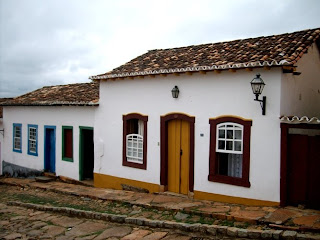18th-century village Tiradentes, just half an hour's bus ride from Sao Joao del Rei (where I stayed 2 nights), was a relaxing place to visit. I can see why it's a popular weekend getaway for escapees from neighboring towns and as far away as Rio and Belo Horizonte. Small and compact, Tiradentes' peaceful cobblestone streets and churches reminded me of an old-world village, but one less exuberant than that of Ouro Preto's.
This lovely rural village in Minas Gerais, set at the foot of the Serra Sao Jose mountain (which offers many hiking trails of various difficulty levels), can surprise and excite any art collector and home-furnishing enthusiast. Its slow pace makes for a perfect setting for a leisurely stroll through its many contemporary artsy shops and galleries - and when tired and hungry, stop for a brief rest at the many cafes and small restaurants. Ah, such luxury from a remote and rural village in Brazil! Who would have thought?!
Here's a tip for travelers wanting to visit Tiradentes - use Sao Joao del Rei as a base and stay near the bus station. It is only a 30 minutes local bus ride away from Tiradentes (bus fare R$2.20 or US$1.00). I have to give my props to Hotel Calcinfer in Sao Joao del Rei, which for a mere R$35/night includes free buffet breakfast and wireless internet AND it is just 5 minutes walk away from the bus station - safe and convenient.
Above right: Igreja Matriz de Santo Antonio - this Minas colonial church's new facade was built and designed by Aleijadinho
Above: Igreja Matriz de Santo Antonio - Gold interior
Above: Igreja Nossa Senhora Rosario dos Pratos - Tiradentes' oldest church (1708), built by and for the slaves; Above right: Panels on the ceiling of Igreja Nossa Senhora Rosario dos Pratos representing Christ's passion and life
Above: The main altar of Igreja Nossa Senhora Rosario dos Pratos
Above left: Contra-file con arroz, feijao, salada e farofa - a traditional Mineira dish (@ Restaurante Tempero da Roca - a budget-friendly, family eatery in Tiradentes)
Above: Check out the wide selection of Cachaca (Brazil's popular alcoholic distilled sugarcane juice, with an average alcohol concentration of 38-48%. Only 1% of Cachaca produced is exported - it is an important ingredient of Brazil's infamous cocktail Caipirinha)
Above: Conserva Sao Jose - this fountain is fed by a stone aqueduct, the source of which is spring water from the nearby forest, Mae D'agua (Mother of the water)
Above left: A short hike on the spring water trail; Above right: The source of the Conserva Sao Jose
Next post: Travel tips (or if you wish to skip this, then head on to Foz do Iguacu, Brazil)
Previous post: Ouro Preto, Brazil

























No comments:
Post a Comment